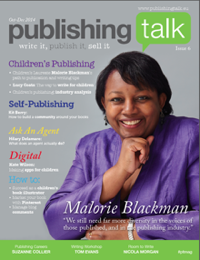Jon Reed's Blog, page 11
January 25, 2016
10 things to consider when choosing a publisher
Choosing the right publisher is vital to the process of getting published, says Mindy Gibbins-Klein.

Choosing the right publisher is vital to the process of getting published, and with such a wide variety of markets and publishing options available, it’s critical that authors research those options. To help shed some light on the process of finding a publisher, I’ve put together a list of top tips from my 14 years of experience.
Be aware of the different choices you have. The publishing industry is evolving and as well as traditional publishing there are a variety of routes for an author and options for them to invest in their own work, either through self-publishing or cooperative publishing.
Know how traditional publishing houses work. Usually they will look to to guarantee a good return on investment and are looking for something that sounds new and innovative while also being reliably marketable. Publishers look at trends in book sales to establish whether there’s a market for your book. It is important to remember that new markets are created all the time, and all it takes is a spark of inspiration, a little research and lots of dedication.
Have specific targets in mind. Know what you want go get out of the process in addition to book sales.
Be open-minded about your work. Strike a balance between the integrity of your work and the potential for publishers and editors to improve it. Publishers have the experience to turn a great idea into a commercial success with often minor tweaks. After all, both of you want to produce the best book possible.
PR is the best way to get news out and achieve media coverage. Research your publisher’s PR department as a third party endorsing you will add a lot to your credibility and means you don’t have to ‘sell yourself’. Some companies use their marketing department for PR, the effectiveness of which depends on the sort of relationships these departments can forge with key contacts in the media. PR is a full time job which is best done by professionals.
Don’t waste too much time chasing a book deal. It typically takes 12-18 months from signing the contract to seeing a book in print. If your plan A is to secure a traditional publishing deal, I recommend you consider your Plan B to be taking control of the process and either self-publishing or using the services of a cooperative publisher.
Call in the professionals. If you do invest in your own book, consider using a full-service or a cooperative publishing partner, who can do a lot of the leg work for you, managing the entire project and reaching more outlets and readers than you could do on your own. Take the most professional path you can afford; the best cooperative publishers launch your book to the media and get it listed with hundreds of sites in addition to Amazon. They will get your book into bricks and mortar stores and can even arrange translation deals.
Edit your work. Whatever route you take, make sure that you’re using a professional editor with plenty of experience working on full-length books.
Get to know your publishing team. You will be speaking to them on a regular basis, so it’s vital that you get to know your publishing team and know how they work as a team. Working with the right team is critical, so it’s important that you’re compatible and get along. You’ll know straight away if the fit isn’t right for you.
Seek guidance from the beginning. It would be a shame not to seek the advice which could turn a great idea into a commercial success; remember the experience publishers have and take advantage of their skills to complement your own.


November 5, 2015
Social media – the pros and cons for writers
Social media is a wonderful tool for writers. But the key is to use it, and not let it use you, says Emily Benet.
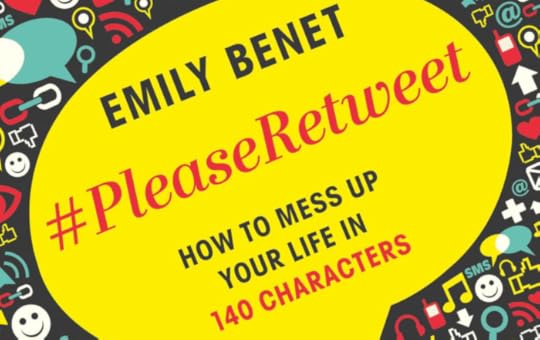
I sometimes wonder where I would be in my writing career if it wasn’t for social media. My first book, Shop Girl Diaries, started life as a blog, my second, The Temp, as a serialised novel posted online, and my latest, #PleaseRetweet, is a comedy about social media obsession.
You would think I’d only have positive things to say about it. But I’m not immune to the pitfalls. There is a high chance, for instance, that I get distracted by a Twitter notification while I’m writing this and… what was I saying?
Here are some of the pros and cons of social media for writers:
Pro: You Can Build an Author Platform
You don’t need an agent or a publisher to tell you when you are an author. In an afternoon you can set up your author blog, create your author Facebook page and open your author Twitter account. Dada! Here I am world, I am an author. Best of all, it’s free.
In fact, don’t wait for a publisher’s validation before you build an author platform. Publishers prefer if you have all that set up already, and traditionally published or not, you will be expected to do your own marketing.
Social media has broken down barriers and continues to challenge the prejudices and limitations of the traditional publishing industry. What matters now is not getting a publisher, but getting potential readers. How do you get readers? Use your online author platform to attract them! If you can get enough readers then the publishers will come. If you get enough, you don’t even need a publisher! In this sense, social media is empowering for writers.
Con: Your Concentration is in Danger
Hang on, just because you’ve created a Facebook page, doesn’t mean you’re an author. You’ve got to write books too! That’s where social media can ruin everything. It’s so distracting.
To write a novel you need to have powers of concentration. The constant checking, and scanning, and scrolling that you do on social media can really start to erode your attention span. It’s so easy to click over to Facebook or Twitter when you get stuck, and before you know it, you’ve lost half your day watching videos of cute, baby animals.
Perhaps your weakness isn’t baby animals but updating your followers. Yes, fine, you’re engaging with your audience, but at the end of the year, do you want to have a finished novel or an active Twitter account?
I recommend setting a timer when you write and banning social media for the duration of that time. I set mine for 45 minute stints. You can also download the Anti-Social app, which prevents you going on the sites that distract you most.
Pro: No More Networking Phobia
Does the idea of networking bring you out in a cold sweat? With social media you can do plenty of networking without leaving the comfort of your writing cave. You can engage with editors, publishers, event organisers, readers, writers easily on Twitter. Seek them out by entering keywords into the Twitter search bar and then create lists so the people and tweets of interest don’t get lost in your busy Twitter feed.
Don’t go online just to broadcast your own message or to only promote your book, but communicate with people, like you would if you were face-to-face. Before you go to a conference or event, find out who is going from Twitter. It makes it much easier to greet people in person after you’ve interacted online.
Con: Everybody Hurts
How will you feel if you get a negative comment on your blog or a bad book review on Goodreads? If you don’t think you could cope, then you shouldn’t go on social media. If, however, you think you can grow a tough skin, then proceed.
It wouldn’t be normal if everyone liked your book or agreed with your opinions. Try not to take it personally. Never argue with people that don’t like your book or try too hard to justify yourself. It’s totally pointless and it makes you look like a bad loser. Thank people for their opinion graciously and leave it at that. If people insult you or are abusive, that’s totally different. Don’t think twice about blocking them from your networks.
Pro: Community Spirit
Most people’s experience on social media is a positive one. If it wasn’t, it wouldn’t be so successful. Type in #amwriting in the Twitter search bar and you’ll find a huge writing community who are really supportive.
Follow and engage with book bloggers, comment on their blogs, share their posts. When your book comes out, they’ll be your cheerleaders. Writing can be a solitary business, but social media offers a virtual watercooler where you can find some great company.
Con: Emotionally Draining
Not only is social media a great tool for procrastination, but it can also be emotionally draining because it’s difficult to filter. One minute I’m chuckling at a one liner on Twitter, and the next I’m getting upset by images of war.
Strive to create the online environment you want to live in. Again, use lists and mute people whose tweets bring you down. Sometimes you like the person tweeting, but not the tweets, so mute them. I’m not saying ignore the news, but your job is to write and you’re not going to write if every time you go on social media you’re questioning the meaning of life.
Pro: Land of Opportunity
Being active on social media can lead to interesting opportunities. Use it to connect, use it as a search engine to find out about writing events, industry news, competitions and what magazines are looking for submissions. Connect with book bloggers and other writers and build a community which will cheer you on and help promote your book.
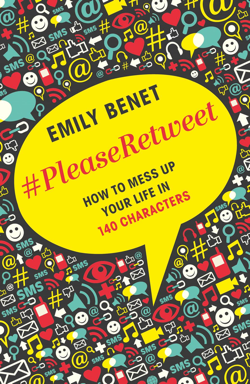 The cons of social media are mostly down to you and your will-power. If you’ve got a lot of followers but you’re not making progress with your book, then readdress the balance: Write more, tweet less! If you don’t know if you’re addicted or not, take a week off. Trust me, you won’t lose followers. I did it recently. I deleted all the apps from my phone and observed the incessant chatter of my social media-adapted brain. After a while it quietened down and I regained control.
The cons of social media are mostly down to you and your will-power. If you’ve got a lot of followers but you’re not making progress with your book, then readdress the balance: Write more, tweet less! If you don’t know if you’re addicted or not, take a week off. Trust me, you won’t lose followers. I did it recently. I deleted all the apps from my phone and observed the incessant chatter of my social media-adapted brain. After a while it quietened down and I regained control.
The key is to use social media, and not let it use you.
Emily Benet’s new book #PleaseRetweet: How to Mess Up Your Life in 140 Characters is published by HarperCollinsUK today.


May 18, 2015
How to crowdfund your book
Indie bestseller and self-publishing expert Ben Galley shares his top tips for crowdfunding your book.
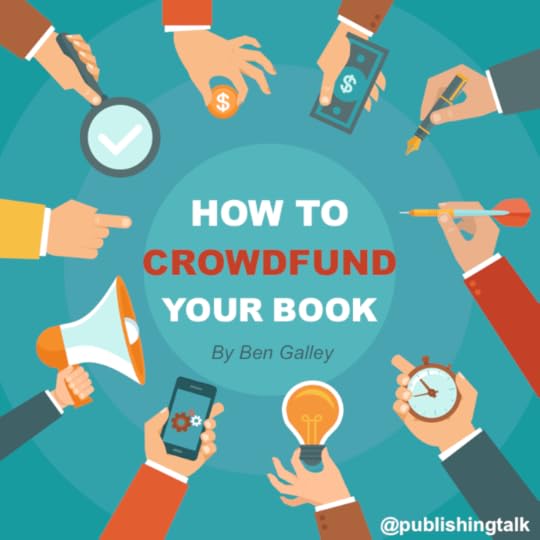
Looking to self-publish but tight on funds? Want to build a fanbase before you’ve even released a book? Or, perhaps you want to fund a special project like a graphic novel or audiobook? If that’s you, then crowdfunding might just be your new best friend.
Crowdfunding is a great way of raising funds using the power of the crowd, acting almost like an advance that you can channel in to publishing costs or new projects. Better still, that crowd can become your loyal fans as well as your investors, meaning you’ve got contacts already ready and waiting before you’re even on the shelves.
Q. So what exactly is crowdfunding?
A. Crowdfunding is a method of fundraising whereby you can fund projects, startups, and ideas using a crowd – an online community that pools resources such as skills, advice, or in the case of crowdfunding, funds! In essence, it’s a way of bringing together people who need to raise money with people who want to donate it, and invest in backing new, interesting projects.
Q. How does it normally work?
A. Generally speaking, you post a project on a crowdfunding platform outlining your goals, plans and why people should back you. Then, by the strength of your idea, your rewards and your marketing, people will back your project. Normally you have to raise a certain amount of money within a certain time limit. If you’re successful in that time, the funds are transferred to you and you can get cracking on your project.
Q. What’s in it for the backers? Why would somebody crowdfund me?
A. On most crowdfunding platforms, you can offer rewards to your backers in return for investment. Rewards can vary from project to project, but usually include a copy of the finished product, or something unique and exclusive to the project itself, like merchandise or signed copies.
People who support a crowdfunding project also get to help bring it to life, and get an inside look at the creative process. In short, they get to be involved, and that’s a great feeling on its own.
Q. Can authors use crowdfunding?
A. Yes indeed. Crowdfunding offers a unique opportunity for independent authors, in the way that you can raise money ahead of publishing a book, funding your time and your publishing process ahead of release. You can also use it to gather fans before your book is out, as well as use it testing out the commercial potential of ideas for new books.
Q. How much can I raise?
A. The amount will vary from project to project, and whether you reach it depends on what you’re trying to achieve, the strength of your idea, and also your outreach and marketing (see below). It’s not uncommon to see successful book projects raising between £1,000 and £5,000.
Q. Does crowdfunding take a lot of work?
A. If you want your project to be successful, then yes. Crowdfunding should be given us much work as the actual publishing of the book itself. The success of your project doesn’t just depend on your idea, your concept, and your passion, but also on your ability to market and drive people to your project.
Successfully funding a project requires a lot of thought, time and effort. You need to be able to reach out to people n the right places, using online communities and social media to drive traffic and interest. A couple of tweets here and there doesn’t quite cut the mustard. You’ll need to be marketing constantly before and during the project.
Q. Does it cost money to crowdfund?
A. Usually, no. The main crowdfunding platforms at our disposal simply take a percentage of the money raised. And, if you aren’t successful, there are usually no fees at all.
Q. Do I have to give away any rights?
A. Not at all. Crowdfunding platforms allow you to keep 100% ownership of the finished product, though you do have a responsibility to use the funds in an appropriate way, and of course deliver a product at the end of it.
Q. What can I crowdfund?
A. The world of crowdfunding is vast, weird and wonderful, but is centred on the completion of a goal and the creation of a product. This could be a film, a game, a gadget, an album and, of course, a book. The most successful projects do tend to have an X factor, an element of cool about them, or be clever, so try to give your project a little twist, and describe it as compellingly as possible.
Q. Where can I start crowdfunding?
A. There are a few major crowdfunding platforms that you can use. Here’s a breakdown of their details:
Kickstarter has raised over $1 billion from over 7 million projects since its launch in 2009, funding more than 77,000 creative projects. 44% of Kickstarter projects reach their goals, and millions of people visit Kickstarter every week. 6703 publishing projects have been successfully published on Kickstarter.
Great organic traffic
Easy-to-use dashboard, both for during and after your projects
Easy to contact if you have a problem
All projects must go through an approval process
Fees: 5% of the funds raised, plus payment processing fees of 3-5%.
Website: www.kickstarter.com
Indiegogo was launched in 2008, and has a wider remit than Kickstarter, allowing people to back creative projects as well as charitable causes and startups. From aggregated data their overall success rate is 34%. Indiegogo will also pay out on partially-funded projects, called flexible funding, but this incurs a fee of 9%.
Projects don’t have to be approved by Indiegogo
Varied and wide project types
You can offer multiple or bulk quantities of a reward
Campaigns are very easy to launch
Fees: 4% (or 9% for part-funded projects), plus payment processing fees of 3-5%
Website: www.indiegogo.com
Pubslush is a niche crowdfunding platform that focuses on the literary world, providing services to authors, publishers, and literary projects. Projects can be launched with a top goal and a minimum goal, giving you flexible funding. All projects must raise a minimum of $500. You can also offer rewards, and the dashboard is very similar to Kickstarter’s.
Easy-to-use dashboard, both for during and after your projects
Campaigns can be approved within 24 hours
Post-project benefits include a sales page and in-house literary agent
More specific audience thanks to literary focus
Fees: 4%, plus a 3.5% processing fee
Website: www.publsush.com
Ben Galley works as a self-publishing consultant and Guardian Masterclass tutor, helping fellow authors to publish and sell their books at www.shelfhelp.info. Read his advice on getting started on social media in issue 7 of Publishing Talk Magazine.
Have you used crowdfunding to publish a book? Share your experience in the comments below.


April 20, 2015
Publishing Talk Magazine issue 7 – Self-Publishing
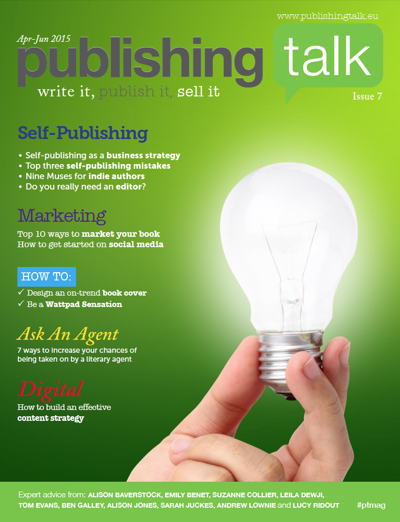 Learn how to design your own book cover, self-publish successfully, and market your books in issue 7.
Learn how to design your own book cover, self-publish successfully, and market your books in issue 7.
The PDF edition is FREE to download right now (7.5 MB).

Issue 7 is also available as a print-on-demand magazine from MagCloud.
A text-only Kindle edition will be available from Amazon soon. Back issues of Kindle editions are available at Amazon.com and Amazon.co.uk. Back issues of PDF editions can also be downloaded for free from this site.
Please join our mailing list for details of our next issue and new resources.
In this issue:
How to create an on-trend book cover – a 3-page, 5-step tutorial by Sarah Juckes
Top three self-publishing mistakes and how to avoid them – Leila Dewji
Do you really need an editor? Lucy Ridout shows you how to hire an editor
Top 10 ways to market your book – Alison Baverstock’s advice for indie authors
How to get started on social media - indie bestseller Ben Galley’s top tips
Self-publishing as a business strategy – Alison Jones on why your book is your greatest marketing tool
How to build a content strategy – insights from Publishing for Digital Minds from Jon Reed
Nine Muses for indie authors – Tom Evans on the multiple sources of inspiration needed
How an agency sells its authors – Andrew Lownie on how to increase your chances of being taken on
How to be a Wattpad sensation – how Emily Benet went from self-publishing to a publishing deal
10 golden rules for work experience – Suzanne Collier on how to make the most of your placement.
Is everyone a publisher now? That’s the question that was posed by a one-day conference I recently attended at Kingston University, at which several Publishing Talk contributors spoke. Certainly it has never been easier to self-publish – but that doesn’t mean you should press the ‘publish’ button too quickly!
There is a lot of practical advice in this self-publishing themed issue to help you get it right, from avoiding common mistakes (p5) to making sure your book is well edited (p6) to a 3-page tutorial on designing your own book cover (p10). If you’re an indie author you have to do everything, including marketing. Tom Evans shares his thoughts on nine Muses needed by indie authors (p16), Alison Baverstock outlines the top 10 ways to market your book (p8), and Ben Galley gets you started with social media (p7).
Self-publishing isn’t just for fiction authors: Alison Jones shows how you can use it as part of a business strategy (p13); and Jon Reed offers some thoughts on content marketing gleaned from this year’s Publishing for Digital Minds Conference (p14).
Do you need an agent if you self-publish? Andrew Lownie offers his thoughts, along with advice on how to get an agent (p18). Some authors self-publish first with a view to getting a traditional deal – Emily Benet did that by serializing her novel online using Wattpad (p22), and shares her advice.
Hope this issue helps you achieve your self-publishing goals!
Now also available as a print-on-demand magazine from MagCloud.
You might also like…
Page preview
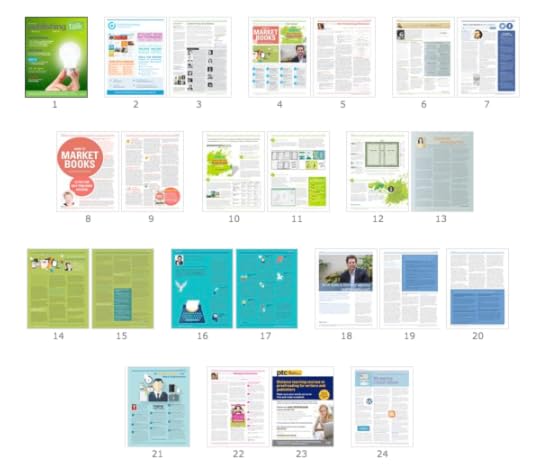
What we’re talking about in this issue
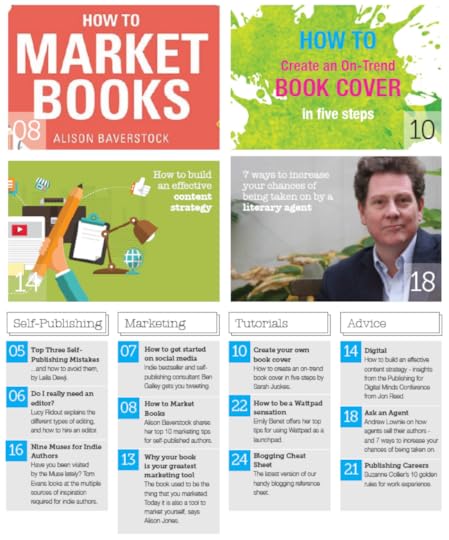
Download PDF editions for free
The PDF edition of issue 7 is available for free as a direct download now (7.5 MB).
 Missed an issue? PDFs of all back issues are now available to download for free.
Missed an issue? PDFs of all back issues are now available to download for free.
Kindle editions are also available at Amazon.com and Amazon.co.uk.
Sign up to our mailing list to be the first to hear about new issues and resources.


April 10, 2015
Why Lauren Child’s new Charlie and Lola book is all about numeracy [INTERVIEW]
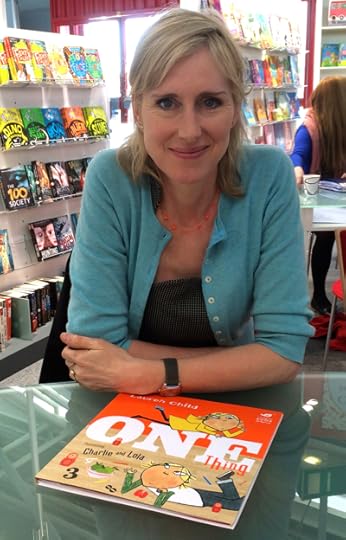 The taxi is late, so as I wait for Lauren Child to arrive at Bologna Children’s Book Fair, I have a chance to get a proper look at One Thing, the first Charlie and Lola book for five years, which brings Child’s unique vision to focus on numeracy, as she has done previously with literacy. Charlie and Lola is a proper publishing phenomenon, with its own trademark, CBeebies animated TV series – and a LOT of books. Child wrote the first Charlie and Lola title, I Will Not Ever Never Eat a Tomato, in 2000, and won the Kate Greenaway award for it, setting her on the road to fame and fortune. This latest addition to the oeuvre is psychedelically bright, with an eye-catching fluorescent orange cover, and as I turn the pages, I find myself beginning to smile, and then laugh.
The taxi is late, so as I wait for Lauren Child to arrive at Bologna Children’s Book Fair, I have a chance to get a proper look at One Thing, the first Charlie and Lola book for five years, which brings Child’s unique vision to focus on numeracy, as she has done previously with literacy. Charlie and Lola is a proper publishing phenomenon, with its own trademark, CBeebies animated TV series – and a LOT of books. Child wrote the first Charlie and Lola title, I Will Not Ever Never Eat a Tomato, in 2000, and won the Kate Greenaway award for it, setting her on the road to fame and fortune. This latest addition to the oeuvre is psychedelically bright, with an eye-catching fluorescent orange cover, and as I turn the pages, I find myself beginning to smile, and then laugh.
By the time Child arrives on the Hachette stand all in a flurry and desperate for coffee and a snack, she has converted this maths-hating writer into a fan of all things number. The child voices are perfectly pitched – How many leaves? “A hundred,’ says Lola. “Nearly at least” – and the illustrations are trademark Child, although fifteen years down the line, she tells me, ‘my art style has changed – I’ve found better ways of doing things. The line weight is thicker, and the look is cleaner, even though I needed to keep the characters close to where they began.’
When I ask why it has been so long since the last Charlie and Lola book, Child says that after many solid years of immersion, she was ‘Charlie and Lola’d out.’ She tells me that she was too wrapped up in the TV show to think about and look at her own characters with any perspective, and needed a break. ‘Book Charlie and Lola are more about wide-eyed innocence than TV Charlie and Lola, who are a bit more knowing,’ and it took her time to get back to that feeling. She’s also been tied up with other projects – each of her Ruby Redfort novels are about 85,000 words long – so that has also been a factor.
One Thing is not a new story per se. It’s been scribbled down in one of Child’s notebooks for some time now, awaiting the right moment. I ask her why she wanted to do a book about numbers and numeracy, and the answer is fascinating. Child aims to do for numbers what she’s already done for language and literacy. She says that all language is new for kids, and they talk about it in a different way to adults. They approach numbers in the same way, experimenting, feeling their way towards the right way to use and understand them, and making mistakes along the way, like Lola saying fifty or twenty seventeen ladybirds, for instance.
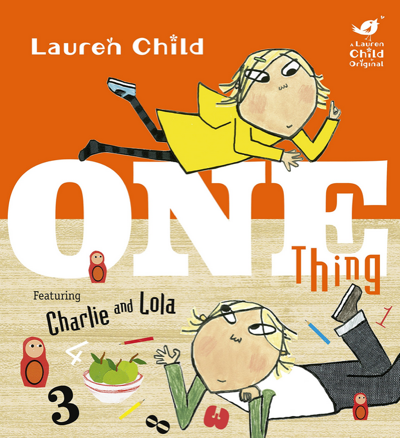 Child herself was not particularly excited by numbers until she discovered they were a big part of music and art. Now she is passionate about sharing her discoveries with kids. She doesn’t see One Thing as a teaching aid – but wants to express her feeling that numbers are a joyful thing.
Child herself was not particularly excited by numbers until she discovered they were a big part of music and art. Now she is passionate about sharing her discoveries with kids. She doesn’t see One Thing as a teaching aid – but wants to express her feeling that numbers are a joyful thing.
‘Children learn to count almost immediately – it doesn’t have to be right at once. Part of the learning process is the discovery of patterns and experimenting with them,’ she says. ‘For instance, time is told in lots of different ways – it doesn’t have to be a headache. I love the fact that numbers can go on and on to a squillion (if that even is a number) or infinity – they don’t just stop at ten.’ Within the book, she has tried to convey that joy by using many different numerical fonts on the page to catch the eye. ‘I could always see this book visually – numbers are in everything, they are everywhere.’
In another of Child’s books, the character Clarice Bean is pictured balancing on the word ‘balance’, and she says she wanted to play much the same visual trick here. Luckily, in David Mackintosh, she has a designer who absolutely understands what she is trying to achieve. Child has a rule of ‘no more (and if possible less) than 80 words on a page.’ She also always reads her work out loud to check it. ‘Reading stuff out loud is unforgiving – you can’t get away with a badly written sentence. You have to know why you are using a word and not be self-indulgent.’
I ask what she thinks of her earlier work now, and she laughs. ‘Sometimes I want to go back and rewrite, because years later, you know, you’ve learned stuff.’
There is one thing that can’t be learned though – and that’s talent. All of Child’s books have that, and the essential quality of readability, in bucket-and-spadefuls. The next generation of children – and their parents – are going to have such fun sharing this lovely book. I only wish I’d had One Thing when I was small. Perhaps it would have lit a ‘love numbers’ spark in me, and then I wouldn’t have failed all my maths exams.
One Thing by Lauren Child is published in October 2015 by Orchard Books.


April 8, 2015
Bologna Children’s Book Fair Diary 2015
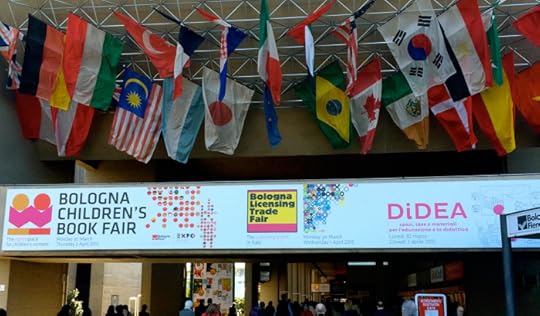
Judging by the huge queues to get in, Bologna 2015 was very much open for business. After negotiating my way past an officious jobsworth of a Fair official, (who refused to believe my Publishing Talk credentials because they weren’t written in Italian), I got my press pass from the office and hurried to my first Monday appointment with Kate Wilson of Nosy Crow (only one of 165 for her team over the four days of the Fair).
Wilson was keen to tell me about David Solomons‘s middle grade fiction debut, MY BROTHER IS A SUPERHERO, coming this July and already sold in seven languages pre-publication. Solomons was the screenwriter for Five Children and It, and the book tackles growing up, sibling rivalry and saving the world. Nosy Crow also has new series fiction from Paula Harrison (THE SECRET RESCUERS) illustrated by Sophy Williams, and from Pamela Butchart, winner of this year’s Blue Peter Book Award (WIGGLESBOTTOM PRIMARY) illustrated by Becka Moon. Picture books are a Nosy Crow strength, and I particularly liked POLES APART – the new Jeanne Willis illustrated by Jarvis. It’s a sweet tale about penguins who get lost and a polar bear who helps get them home – bringing the Arctic and Antarctic together at last! Yasmeen Ismail‘s CHRISTMAS FOR GRETA AND GRACIE, featuring a chatty older sister who always knows best and a nice Santa-based twist was another one which caught my eye. Wilson tells me that business was good in 2014, with a 42% growth in book sales. However, sounding a cautionary note, she says that the strength of the dollar vs the euro has meant that co-edition margins are harder to make work, and pricing is difficult, particularly for novelty books. Nonetheless, it is clear that a small company like hers can be fast, responsive and personal (in contrast to the behemoths, which can take months to respond).
Talking of behemoths, my next appointment was at the huge (and slightly confusing) joint Penguin Random House stand to meet Puffin Editorial Director, Ben Horslen. First up is David Hofmeyr‘s June debut UKYA novel, STONE RIDER, a dystopian love story described by Horslen as ‘THE HUNGER GAMES meets THE ROAD’, which will have a major transatlantic launch with Random US and is already in development as a film for Working Title. Forthcoming excitements for 2016 are another debut (first of an upper middle-grade trilogy) from Dave Rudden titled THE KNIGHTS OF THE BORROWED DARK. It lies in Eoin Colfer/Derek Landy territory, with black humour and an orphan hero called Denizen Hardwick. Sounds very promising. Also coming in 2016 is the final trilogy in the Sally Green‘s Half world – HALF LOST – in which Horslen promises ‘there will be blood.’ Having interviewed Green about the books recently, I believe him! Horslen feels that the biggest publishing challenge is still the debut book, that brands and large series continue to thrive, and that Waterstones is still ‘very very important’ in the UK book market. He’s a fan of UKYA, and says he is ‘always going to be building the next big thing – but it takes time.’
 The sunshine was too much of a draw, so my next meeting with David Maybury – Commissioning Editor at Scholastic UK – took place outside. In December 2014, Maybury signed up teen pop, HuffPo and YouTube sensation Tallia Storm in a two-book deal to write a fictionalised story of her life. The first, STORM FEVER, is hitting bookshelves in October 2015. Maybury openly admits that this is a collaborative effort with a professional (unnamed so far) ghostwriter. ‘Tallia is only 16 – she needed help’, but says that the short story which will be released on May 10 to coincide with her new single was written entirely by the young singer. I think this could possibly be one to challenge Zoella’s supremacy at the top of the charts.
The sunshine was too much of a draw, so my next meeting with David Maybury – Commissioning Editor at Scholastic UK – took place outside. In December 2014, Maybury signed up teen pop, HuffPo and YouTube sensation Tallia Storm in a two-book deal to write a fictionalised story of her life. The first, STORM FEVER, is hitting bookshelves in October 2015. Maybury openly admits that this is a collaborative effort with a professional (unnamed so far) ghostwriter. ‘Tallia is only 16 – she needed help’, but says that the short story which will be released on May 10 to coincide with her new single was written entirely by the young singer. I think this could possibly be one to challenge Zoella’s supremacy at the top of the charts.
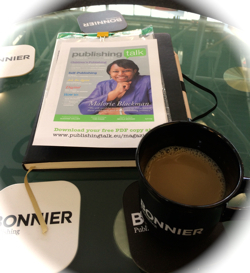 Diving back into the busy halls, I had coffee at the enormous white Bonnier stand with Matilda Johnson – Senior Editor at Hot Key and Piccadilly Press. Hot Key have teamed up with Disney to co-publish Daniel Kraus and Guillermo del Toro’s TROLLHUNTERS (described to me as ‘the Goonies meets Pan’s Labyrinth’) which sounds both amazing and disgusting at the same time (trolls throwing up their guts to be light enough to climb up a house, anyone?). It’s sure to appeal to both teens and adults. New author, Rachel Delahaye, brings a ‘whacky lighthearted’ middle-grade series to the Piccadilly stable. JIM REAPER hits the shelves in 2016 and is about a boy discovering that his dad is not really an accountant, but works instead for the creepy ‘Dead End Office’. If you’re a fan of alternative history, there’s Julie Mayhew‘s latest – THE BIG LIE – set in a present day Nazi England. I’ve now read the proof, and it’s a real cracker of a story, which I predict will be on prize lists. Last, but very much not least, comes a new direction for current Queen of Teen, James Dawson, with ALL OF THE ABOVE – a contemporary YA which ‘pushes the barriers of teen romance’. It’s bound to get a lot of coverage, with the long-awaited rise of LGBTQ lit in the UK.
Diving back into the busy halls, I had coffee at the enormous white Bonnier stand with Matilda Johnson – Senior Editor at Hot Key and Piccadilly Press. Hot Key have teamed up with Disney to co-publish Daniel Kraus and Guillermo del Toro’s TROLLHUNTERS (described to me as ‘the Goonies meets Pan’s Labyrinth’) which sounds both amazing and disgusting at the same time (trolls throwing up their guts to be light enough to climb up a house, anyone?). It’s sure to appeal to both teens and adults. New author, Rachel Delahaye, brings a ‘whacky lighthearted’ middle-grade series to the Piccadilly stable. JIM REAPER hits the shelves in 2016 and is about a boy discovering that his dad is not really an accountant, but works instead for the creepy ‘Dead End Office’. If you’re a fan of alternative history, there’s Julie Mayhew‘s latest – THE BIG LIE – set in a present day Nazi England. I’ve now read the proof, and it’s a real cracker of a story, which I predict will be on prize lists. Last, but very much not least, comes a new direction for current Queen of Teen, James Dawson, with ALL OF THE ABOVE – a contemporary YA which ‘pushes the barriers of teen romance’. It’s bound to get a lot of coverage, with the long-awaited rise of LGBTQ lit in the UK.
Back to the Scholastic stable again, I met Barry Cunningham, MD and Publisher of Chicken House, minus his trademark tweed ‘Hat of Opportunity’ because of the growing heat. Cunningham tells me that this has been his best publishing year ever, with James Dashner‘s ‘cosmic’ MAZE RUNNERS selling 1,500,000 copies around the world and bringing in boy readers by the barrelful. When Cunningham (who has published no less an author than Roald Dahl) tells you that MG Leonard‘s darkly hilarious debut novel, BEETLE BOY, is ‘one of the best novels I’ve ever published’, you tend to sit up and take notice. He says the science is real and that it reminds him of Dahl’s ‘tough vigour’, billing it as ‘JAMES AND THE GIANT PEACH meets 101 DALMATIANS – with exotic beetles’. The book has sold to twelve countries in two weeks – and Cunningham expects that to grow to thirty or forty. I wouldn’t like to bet against that.
Next up are those splendidly busy squirrels of Barrington Stoke, Sales Director Jane Walker and Publisher Mairi Kidd. In last year’s Bologna diary, I told you about the reading app they were developing for dyslexics. That’s now almost finished with beta testing, and will have its soft launch at London Book Fair. There’ll be six books available initially, and lots of extra content for parents. It looked incredibly impressive on Mairi’s iPad, and I only wish I’d had it when my own kids were small. Barrington Stoke is one of the most impressive indy publishing companies I see at Bologna, regularly attracting international names to their author list, which makes a big difference to the way both booksellers and buyers perceive them. They are consistently recording ‘best months ever’, and sales are up 40% at Waterstones this year. Some forthcoming highlights are GAWAIN GREYTAIL AND THE TERRIBLE TAB, a picture book tale of knightly mouseish derring-do by Cornelia Funke and Mónica Armiňo, and one of the most beautiful books I saw all Fair, a full colour younger novel from Eoin Colfer and Victor Ambrus, with rose gold edges and head and tail bands. There’s also a companion book to BROCK by Anthony McGowan (longlisted for the Carnegie Medal), called PIKE, which looks equally as good as its predecessor. Though progress has been made, both Walker and Cunningham feel that the trade ‘could do more to make books for dyslexics more available’, so shifting those perceptions up a notch to create a real ‘sea change’ is a big theme for Barrington Stoke in 2015.
Up the escalator to the Agents’ Centre and on to my second Barry of the day – Barry Goldblatt – US literary agent. Goldblatt always has a refreshingly honest opinion on the markets. Like Ben Horslen, he maintains that creating a bestseller takes hard work from all concerned. ‘Pick a book and get behind it,’ is his advice to publishers – but he’s also aware of luck and ‘how the dice fall’ having a big effect on sales. Children’s books in the US still make up the bulk of sales, but he has interesting things to say about UK bookstores and the YA phenomenon. He feels that until bookstores here decide to have dedicated YA sections away from the children’s book area, the sector won’t take off as well as it has in the US. ‘When Barnes and Noble did it in the USA, YA exploded. Teens just don’t want to be seen in the part of the store where the babies are.’ It’s a valid point, and one that UK booksellers might like to think about, though given the constraints of space in most indies, it’s unlikely to happen any time soon. Waterstones, are you listening?
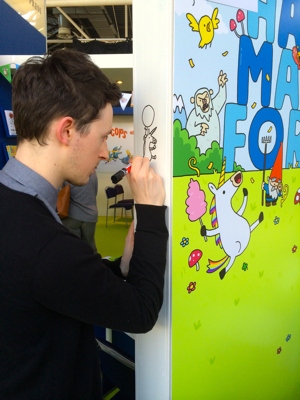 By this time, I’m seriously in need of alcoholic sustenance and a snack, so it’s lucky that OUP Children’s provide the necessary prosecco and nibbles as well as Matty Long (whose SUPER HAPPY MAGIC FOREST is described to me as ‘Tolkien for toddlers’) doing cute live drawing of unicorns all over the stand. Then it’s a quick shower and change and off for a flying visit to the fabulous Palazzo Re’ Enzo (where the first ever Bologna Book Fair was held) for a vast drinks party with Scholastic. It was a pleasure to reconnect briefly with legendary Delacorte VP and publisher, Beverly Horowitz there, who I knew in my New York publishing days. After that there was a wonderful and laughter-filled dinner with the Nosy Crows, where the usual ‘Bologna feast’ was provided – course after course, and the nicest dessert I’ve ever eaten, a strange-sounding but wonderful panna cotta with salted pink grapefruit. Stuffed but happy, we made our way to the notorious SwineBar – heaving with publishing people at 11.30pm. It’s always fun to catch up with the gossip there – and to chat books, writing and pink hair with Laureate na nÓg, Eoin Colfer, who was in Bologna for the worldwide Children’s Laureate summit. Earlier in the day I’d managed to catch up with our own UK Children’s Laureate, Malorie Blackman – cover girl for the October Children’s Issue of Publishing Talk Magazine and accept a challenge from her to cosplay Ancient Egyptian-style at the forthcoming YALC conference in July at London Comic-con. What have I let myself in for?
By this time, I’m seriously in need of alcoholic sustenance and a snack, so it’s lucky that OUP Children’s provide the necessary prosecco and nibbles as well as Matty Long (whose SUPER HAPPY MAGIC FOREST is described to me as ‘Tolkien for toddlers’) doing cute live drawing of unicorns all over the stand. Then it’s a quick shower and change and off for a flying visit to the fabulous Palazzo Re’ Enzo (where the first ever Bologna Book Fair was held) for a vast drinks party with Scholastic. It was a pleasure to reconnect briefly with legendary Delacorte VP and publisher, Beverly Horowitz there, who I knew in my New York publishing days. After that there was a wonderful and laughter-filled dinner with the Nosy Crows, where the usual ‘Bologna feast’ was provided – course after course, and the nicest dessert I’ve ever eaten, a strange-sounding but wonderful panna cotta with salted pink grapefruit. Stuffed but happy, we made our way to the notorious SwineBar – heaving with publishing people at 11.30pm. It’s always fun to catch up with the gossip there – and to chat books, writing and pink hair with Laureate na nÓg, Eoin Colfer, who was in Bologna for the worldwide Children’s Laureate summit. Earlier in the day I’d managed to catch up with our own UK Children’s Laureate, Malorie Blackman – cover girl for the October Children’s Issue of Publishing Talk Magazine and accept a challenge from her to cosplay Ancient Egyptian-style at the forthcoming YALC conference in July at London Comic-con. What have I let myself in for?
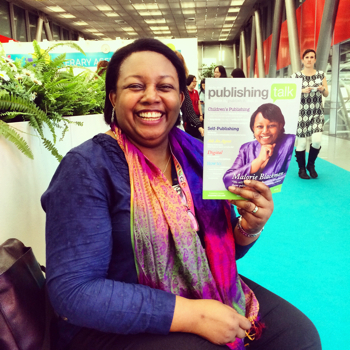 Tuesday dawned clear and hot again, and (propping up my eyes slightly after a 2am bedtime) I rushed from the bus to meet Liz Cross, Head of Publishing at OUP Children’s. This is a publisher which continues to go from strength to strength, with the successful Sarah Macintyre and Philip Reeve partnership producing a new madcap adventure for September – PUGS OF THE FROZEN NORTH. Carnegie Medal-winner Reeve also has a new novel, RAILHEAD, which Cross describes as set in an ‘epic Reeves-esque universe, with sci-fi elements’. Film rights have already been sold to Warner Brothers, and I can’t wait to read this one, as I’m a huge Reeve fan. Roland Chambers – ex pastry chef and private investigator – hits the shelves with his debut MG adventure novel, NELLY AND THE QUEST FOR CAPTAIN PEABODY, with two-colour illustrations by Ella Okstad. Cross describes this one as having elements of Pippi Longstocking – and it looks promising. There are certainly more two-colour illustrated titles at the fair than I remember seeing for some time – it’s looking like a trend.
Tuesday dawned clear and hot again, and (propping up my eyes slightly after a 2am bedtime) I rushed from the bus to meet Liz Cross, Head of Publishing at OUP Children’s. This is a publisher which continues to go from strength to strength, with the successful Sarah Macintyre and Philip Reeve partnership producing a new madcap adventure for September – PUGS OF THE FROZEN NORTH. Carnegie Medal-winner Reeve also has a new novel, RAILHEAD, which Cross describes as set in an ‘epic Reeves-esque universe, with sci-fi elements’. Film rights have already been sold to Warner Brothers, and I can’t wait to read this one, as I’m a huge Reeve fan. Roland Chambers – ex pastry chef and private investigator – hits the shelves with his debut MG adventure novel, NELLY AND THE QUEST FOR CAPTAIN PEABODY, with two-colour illustrations by Ella Okstad. Cross describes this one as having elements of Pippi Longstocking – and it looks promising. There are certainly more two-colour illustrated titles at the fair than I remember seeing for some time – it’s looking like a trend.
Onto the Random House Children’s Books side of the PRH stand this time, to see Children’s Fiction Publisher Annie Eaton and Editorial Director Ruth Knowles. The main excitement at RHCB is AREA 13 – the first in a totally new Joseph Delaney trilogy, set to be ‘as big as SPOOKS’ and described as ‘Percy Jackson meets THE HUNGER GAMES, with gladiatorial contests, evil monsters and a distincive Delaney twist’. Five foreign publishing deals had already been put together pre-Fair, including France and Brazil. There’s also a buzz aroud Laurence Anholt‘s first YA novel – THE HYPNOTIST – which Eaton and Knowles term ‘uncategorisable’, and describe as ‘NOUGHTS AND CROSSES meets THE HELP by way of GREAT EXPECTATIONS’. (You’ll have noticed by now that publishers are keen to use this sort of shorthand pitch to describe their offerings). Set in 1960s America, the novel features the Ku Klux Klan, a black boy adopted by white sharecroppers, and a hypnotic Irish psychotherapist overlooking all the drama from his house on the hill. Colour me intrigued! The book was sold to Mondadori at the Fair, and seems to me like the perfect teen/adult crossover. It will be published in Jan 2016. Eaton has also signed up debut Irish author Moïra Fowley-Doyle, whose THE ACCIDENT SEASON – an atmospheric standalone about strange first love – has already been sold to Penguin US and a German publisher. Described as a ‘modern I CAPTURE THE CASTLE with a curse’, I’m told that Fowey-Doyle has a voice as distinctive as Patrick Ness, with the darkness of Neil Gaiman. I very much look forward to seeing the proof of that when the book comes out in July.
My first visit to the gigantic Hachette stand is to see Anne McNeil, Publishing Director of Hodder.
It’s a little embarrassing to have to admit that McNeil made me cry, quite literally, over Mick and Chloe Inkpen’s newest picture book, I WILL LOVE YOU ANYWAY. It’s a touching and brilliant story about a naughty poo-rolling runaway dog, which definitely tugged at my heartstrings, and one I’ll be buying for all small children in my family this Christmas. There’s also a new Hiccup story, HOW TO FIGHT A DRAGON’S FURY – the twelfth in Cressida Cowell‘s HOW TO TRAIN YOUR DRAGON series, in which Hiccup is ‘alone and lost’. McNeil says the story has an epic arc of pathos, and a ‘big world vision’. Apart from that small hint, content is embargoed will a limited first release to selected child readers at Edinburgh Book Festival in August. Publication is in October.
Putting away my hanky, I scurry back to the Agents’ Centre, where I am hearing rebellious mutters from all concerned at the lack of dedicated loos and bottled water. When you’re an agent with back to back interviews, it’s unfair, if not inhuman, not to provide these, and a strongly-worded letter of protest was circulating as I sat down in the cafe for a coffee with Fiona Kenshole of the Transatlantic Agency. Kenshole has a unique perspective on the UK and US markets, having been Editorial Director at Harper Collins, as well as holding many other senior posts before she jumped into the agenting arena. She agrees with Barry Goldblatt that it is much more punishing to build an author in the UK – and to publish standalone novels. She also believes that we need more ‘maverick publishers’ with the bravery to take on a book that is different and unusual, rather than a safe bet. Hear hear to that!
It’s always interesting to talk to a brand new publisher – especially one from an emerging market. Last year I wrote about India as a growing force in children’s books, and while sales are slightly down for the import market, the appetite for children’s books perceived to be ‘value for money, informational and educational’, is expanding. I talked to Richa Jha of fledgling English Language indy publishers Pickle Yolk Books, based in Delhi. Jha is an ex-journalist and editor who is passionate about picture books. The trouble is, she says, that in the consciousness of ‘price-orientated’ middle-class book buying parents in India, picture books (because they have so few words) are NOT considered value for money. At the moment she is self publishing traditional print books, but as we sat in the Bologna sunshine, she outlined her hope to expand her list to include more home-grown Indian authors and illustrators. A laudable ambition, and one I very much hope she succeeds in.
It’s always a pleasure to arrive in the Edwardian drawing room that is Faber’s Bologna stand, sink into a maroon plush wing chair and be provided with life-saving chocolate by Commissioning Editor, Alice Swan. Swan tells me that Faber has won Alwyn Hamilton‘s debut YA – REBEL OF THE SANDS – in a four-way auction conducted by The Bent Agency (it went to Penguin US in an eight-way, and Swan will co-edit). Swan describes it intiguingly as ‘Wild West with genie magic, a gunslinger girl and a handsome foreign stranger’, and it will arrive on bookshelves here in February 2016. Slightly closer at hand is the launch of the Greenhouse Funny Prize winner Gavin Puckett’s debut – a rhyming middle-grade series, FABLES FROM THE STABLES. MURRAY THE HORSE will come in June. Another that caught my eye was Alexia Casale‘s new novel. Casale is one of the new wave of talent in UKYA, and her second book (to be published in August) is a coming of age story called HOUSE OF WINDOWS. I much enjoyed her debut, THE BONE DRAGON, and think Casale is one to watch.
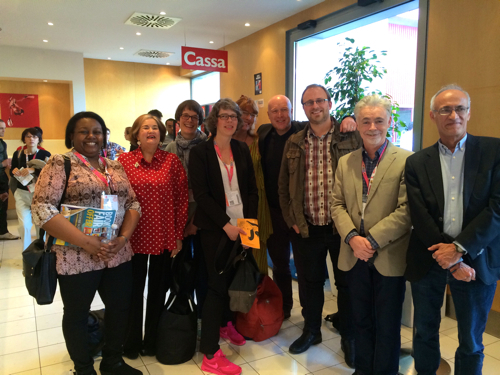 After a quick detour to listen to the nine Children’s Laureates talk about their work (fascinating, and including an audience participation rap in Welsh by Aneirin Karadog, Y Bardd Plant Cymru), the last appointment of the day was back at the Hachette stand with Megan Larkin, Publishing Director of Orchard Books. Lauren Child’s CHARLIE AND LOLA series has been one of Orchard’s great successes – and ONE THING, the first C and L book for five years has the adorable duo tackling numbers and numeracy. I was lucky enough to bag an exclusive interview with Lauren Child at the Fair, and talked to her at length about the joy of numbers. You can read that interview here. [Insert link] Larkin was also keen to show me roughs of Fabi Santiago‘s debut picture book, TIGER IN A TUTU, which she says she bought on the strength of ‘one picture of a boy tiger on top of the Eiffel Tower’. Think Billy Elliott as a travelling dancing tiger – there’s a tiny flavour of Ludwig Bemelman’s MADELINE in the backgrounds, but the art is unique and entirely charming. Another picture book debut – SUPER STAN comes from Matt Robertson – a clever take on the ‘overshadowed sibling’ theme, with a great twist at the end. On the upper middle-grade end of things, New York Times bestselling author Chris D’Lacey is back in dragon territory with THE ERTH DRAGONS (WEARLE BOOK 1), which will be published by Scholastic in the US, and here in October. It sounds amazing.
After a quick detour to listen to the nine Children’s Laureates talk about their work (fascinating, and including an audience participation rap in Welsh by Aneirin Karadog, Y Bardd Plant Cymru), the last appointment of the day was back at the Hachette stand with Megan Larkin, Publishing Director of Orchard Books. Lauren Child’s CHARLIE AND LOLA series has been one of Orchard’s great successes – and ONE THING, the first C and L book for five years has the adorable duo tackling numbers and numeracy. I was lucky enough to bag an exclusive interview with Lauren Child at the Fair, and talked to her at length about the joy of numbers. You can read that interview here. [Insert link] Larkin was also keen to show me roughs of Fabi Santiago‘s debut picture book, TIGER IN A TUTU, which she says she bought on the strength of ‘one picture of a boy tiger on top of the Eiffel Tower’. Think Billy Elliott as a travelling dancing tiger – there’s a tiny flavour of Ludwig Bemelman’s MADELINE in the backgrounds, but the art is unique and entirely charming. Another picture book debut – SUPER STAN comes from Matt Robertson – a clever take on the ‘overshadowed sibling’ theme, with a great twist at the end. On the upper middle-grade end of things, New York Times bestselling author Chris D’Lacey is back in dragon territory with THE ERTH DRAGONS (WEARLE BOOK 1), which will be published by Scholastic in the US, and here in October. It sounds amazing.
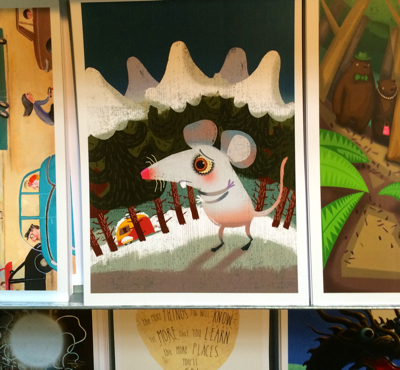 Tuesday night brought more parties – the Irish always have whisky on hand, which may or may not be a good thing, depending on how much you consume. I chatted to Illustrators Ireland representative Margaret Ann Suggs, who had the idea for the fabulous showcards on the stand. Ireland is having a good publishing year, with author Louise O’Neill just having won the inaugural YA Book Prize for ONLY EVER YOURS. There’s also a fantastic new Irish monthly Twitter chat about all things YA, under the hashtag #YAie. Next up was a trip back to the Barrington Stoke party for prosecco, chat and more nibbly bits, before heading off to the depths of San Stefano for some delicious antipasti and a chat with my third US agent, Ginger Clark of Curtis Brown. Ginger alerted me to a fabulous sounding historical thriller coming from Macmillan in spring 2016. THE GIRL IN THE BLUE COAT by Washington Post reporter Monica Hesse, which she sold to Venetia Gosling pre-Frankfurt. With eight foreign deals so far, and an exciting-sounding plot set in 1943 Amsterdam revolving around a black market smuggler who has to find a Jewish runaway before the Nazis do, I think this one might go places. I’ll certainly be on the lookout for it.
Tuesday night brought more parties – the Irish always have whisky on hand, which may or may not be a good thing, depending on how much you consume. I chatted to Illustrators Ireland representative Margaret Ann Suggs, who had the idea for the fabulous showcards on the stand. Ireland is having a good publishing year, with author Louise O’Neill just having won the inaugural YA Book Prize for ONLY EVER YOURS. There’s also a fantastic new Irish monthly Twitter chat about all things YA, under the hashtag #YAie. Next up was a trip back to the Barrington Stoke party for prosecco, chat and more nibbly bits, before heading off to the depths of San Stefano for some delicious antipasti and a chat with my third US agent, Ginger Clark of Curtis Brown. Ginger alerted me to a fabulous sounding historical thriller coming from Macmillan in spring 2016. THE GIRL IN THE BLUE COAT by Washington Post reporter Monica Hesse, which she sold to Venetia Gosling pre-Frankfurt. With eight foreign deals so far, and an exciting-sounding plot set in 1943 Amsterdam revolving around a black market smuggler who has to find a Jewish runaway before the Nazis do, I think this one might go places. I’ll certainly be on the lookout for it.
Having stowed the luggage, it was off for the last day at the Fair, and a final trip to the Hachette stand to meet Fiona Kennedy, Publishing Director of Orion Children’s Books. Kennedy tells me that there is continuing interest in Liz Kessler‘s READ ME LIKE A BOOK, her first older YA novel about divorce, teen relationships and coming out, which will be published by Candlewick Press in the USA. I’ve read a proof already, and can confirm that it grips from the very first page. Phil Earle‘s DEMOLITION DAD is also proving popular, with both UK supermarkets and WH Smith taking it into stores. The main Fair news for Orion, though was that film rights to Lauren St John‘s book THE GLORY have been sold to Simon Brooks at Canyon Creek. Kennedy says they were ‘snapped up in an instant’ from St John’s agent, Catherine Clarke. The other very big deal is a partnership with the Born Free foundation, Virginia McKenna (actress from the original film) and Sara Starbuck to publish three real life animal rescue stories in June.
I have to confess to a personal interest when I mention newly created agency SHA, as Sophie Hicks, its founder, is my own agent. The extremely well-respected Hicks worked for the Ed Victor agency for twenty-five years, latterly as their Managing Director, and went solo last year. She tells me that being her own boss for the first time at Bologna is ‘brilliant – almost like starting again, but without the fear of the unknown.’ She also says that there has been a lot of goodwill, encouragement, and that people are generally very interested in what she has to offer (I’m not surprised – she’s great, and all her authors, including Eoin Colfer, chose to move with her). The just-published Sarah Bannan‘s WEIGHTLESS (Bloomsbury) has already sold to German and Hungarian publishers, and there’s also a lot of excitement around Emerald Fennell‘s (of Call the Midwife) YA novel, MONSTERS, which Hicks describes as ‘THE CURIOUS INCIDENT OF THE DOG IN THE NIGHT-TIME meets THE SHINING’. Coming from Hot Key in September and set in the ever-popular Cornwall, it is a book ‘about two twelve year-olds that is definitely not for kids’.
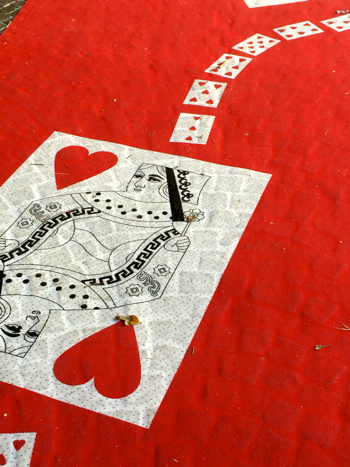 Another ‘new kid on the block’ is Otter Barry Books, recently founded by Janetta Otter-Barry, previously of Frances Lincoln, and another well-known and well-respected face in the children’s books arena. The company won’t be publishing anything till mid next year, but there are some interesting things already on the cards. KANGAROO KISSES, a debut from acclaimed Indian film actress and UNICEF ambassador, Nandana Sen, illustrated by Pippa Curnick, looks a perfect book for procrastinating children who are unwilling to go to bed. There’s also DREAMER, a painterly and poetic book from Brian Moses and Bee Willey, which has an utterly beautiful text and an important ecological message.
Another ‘new kid on the block’ is Otter Barry Books, recently founded by Janetta Otter-Barry, previously of Frances Lincoln, and another well-known and well-respected face in the children’s books arena. The company won’t be publishing anything till mid next year, but there are some interesting things already on the cards. KANGAROO KISSES, a debut from acclaimed Indian film actress and UNICEF ambassador, Nandana Sen, illustrated by Pippa Curnick, looks a perfect book for procrastinating children who are unwilling to go to bed. There’s also DREAMER, a painterly and poetic book from Brian Moses and Bee Willey, which has an utterly beautiful text and an important ecological message.
My Fair wouldn’t be complete without a meeting with John McLay, who now scouts likely books only for UK publishers – as he puts it ‘flying the flag for Britain’. McLay always has a finger on the pulse of publishing, and gives the best overviews of the industry of anyone I know. This year, he’s noticed a ‘plethora of authors’ visiting the Fair, mostly publisher-funded. Could this be an indication of a recovering economy? Or is it just a fact of life that authors need to make themselves available for these kinds of events? Illustrators, of course, are ever present at Bologna, and even more so this year, with at least double the amount of ‘illustrator walls’ to showcase their work, and many publishers holding ‘open hours’ without appointments to trawl for new illustrative talent. I asked McLay what he thinks of the growing UKYA phenomenon. Does it yet provide a challenge to the overwhelming firepower of the US YA trend? Maybe not yet – but as McLay comments: ‘the more we read and prioritise UK authors, the more buzz we will create around UKYA.’ He is certainly doing his bit, saying that he is reading a great many submissions and seeing a lot of books very early from UK agents. This can only be a good thing. As for those trends – ‘there are still a lot of witches for young and old, realistic is still big, as is romance.’ But where that romance is set is key – he’s seen everything from Spain to space. Historical only works if it’s exceptional, and as always, ‘fantasy is ever present.’
 The final meeting of the day was with agents Catherine Clarke and Amy Waite of Felicity Bryan. They were definitely having a good Fair, with Waite having bagged her first big deal with a tightly-contested auction for author Irena Brignull’s YA debut, THE BRIARWOOD PROPHECY, won by Orchard Books in the UK and Weinstein Books in the US. There are also deals with Holland, Germany and France for this ‘modern fairytale’ about a witch and mortal girl swapped at birth. As well as strong interest for new novels from UKYA success stories Jenny Downham, Clare Furniss, and Annabel Pitcher, Clarke has a new potential star on the books with a debut YA from Bath Spa MA graduate and director of a marine conservation charity Christopher Vick. Titled KOOK (meaning a rookie surfer), it has sold to Harper Collins in the UK and Clarke tells me there is already ‘strong interest’ from Holland and the USA. Since I have immense faith (proven over many Bolognas) in Clarke’s ability to spot a winner, this tale of hardcore Cornish surfers will be one to watch for in 2016.
The final meeting of the day was with agents Catherine Clarke and Amy Waite of Felicity Bryan. They were definitely having a good Fair, with Waite having bagged her first big deal with a tightly-contested auction for author Irena Brignull’s YA debut, THE BRIARWOOD PROPHECY, won by Orchard Books in the UK and Weinstein Books in the US. There are also deals with Holland, Germany and France for this ‘modern fairytale’ about a witch and mortal girl swapped at birth. As well as strong interest for new novels from UKYA success stories Jenny Downham, Clare Furniss, and Annabel Pitcher, Clarke has a new potential star on the books with a debut YA from Bath Spa MA graduate and director of a marine conservation charity Christopher Vick. Titled KOOK (meaning a rookie surfer), it has sold to Harper Collins in the UK and Clarke tells me there is already ‘strong interest’ from Holland and the USA. Since I have immense faith (proven over many Bolognas) in Clarke’s ability to spot a winner, this tale of hardcore Cornish surfers will be one to watch for in 2016.
So, another Bologna is over, and the halls are empty of children’s books till next year. What struck me this time was the amount of beautiful illustrated books we will NOT see here in the UK. There is so much talent around, especially in Eastern Europe and it makes me sad that (with very few exceptions) we generally only manage to know about and see titles from our own sector of the market. It’s a humbling experience for an author, visiting Bologna – but I wouldn’t miss it for the world. Viva children’s books and roll on 2016!
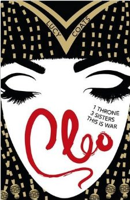 Lucy Coats’s YA novel Cleo is published on 7th May 2015.
Lucy Coats’s YA novel Cleo is published on 7th May 2015.
Read Lucy’s interview with Malorie Blackman in the Children’s Publishing issue of Publishing Talk Magazine – and read her exclusive interview with Lauren Child at this year’s Bologna Children’s Book Fair on the blog this Friday.


March 6, 2015
How to become a children’s book illustrator – 7 secrets for success
This article first appeared in issue 6 of Publishing Talk Magazine, which you can download as a PDF for free.
Steven Lenton is the illustrator of children’s best-seller Shifty McGifty and Slippery Sam which was both Waterstones picture book of the month and The Times children’s book of the week. Since this successful début, Steven has written his first picture book with publisher Nosy Crow, Princess Daisy and the Dragon, as well as illustrating books for Little Tiger, Quercus and Orchard books. Here he shares with us his top seven secrets for success.
 I’m relatively new to the children’s book industry, but in my short time illustrating picture books I have learned some practical and hopefully useful dos and don’ts that I would like to share with you.
I’m relatively new to the children’s book industry, but in my short time illustrating picture books I have learned some practical and hopefully useful dos and don’ts that I would like to share with you.
1. Do get an agent
You may be tempted to go it alone to get the maximum amount of pennies possible on signing a book deal. My advice is to find an agent that can fine-tooth comb contracts, understand you as an artist and treat you to the occasional cream cake. My agent has helped me to promote my portfolio, maximise my fee and very importantly offered a wealth of encouragement and advice about the industry. It’s important to have someone who can deal with the tricky bits and pieces you don’t know how to, allowing you to concentrate on being creative and cakey.
2. Don’t be too precious
The publishing industry, lovely as it is, has to be based on strong book sales. Therefore if you have an idea for a book, be it in whatever form, you must expect a publisher to tweak, edit and often radically change some aspects of your project if it is to be a success. Being open-minded to these changes will help your idea blossom into a best seller. Some books will need few if any alterations, but most of the best books go through numerous drafts. It is possible to maintain your integrity during this process by relaxing a little and by listening to what your editor/designer has to say, digesting it and then discussing it. Over cake.
3. Do continually develop your style
Everybody wants to have a unique, recognizable style and this is essential. Look at classic and contemporary illustrators and observe similarities between your work and others, gain clues on colour, composition and layout, all the while developing the way you draw dogs, noses, elephants, cars, totem poles, whatever it is that you are interested in designing. Play around with mediums (not of the Mystic Meg variety!) and find a style and way of working that you are comfortable with. If you persevere you WILL find your style – it just takes a lot of research and practice.
4. Don’t dismiss a rhyming text
There’s some confusion amongst aspiring authors and illustrators as to whether a rhyming text is viable. Some recent talks I have been to touching on the matter have left audiences believing that a rhyming text is a complete no-no. This is NOT the case. Interestingly, all the texts bar one that have been sent to me by various publishers have ALL been rhyming texts.
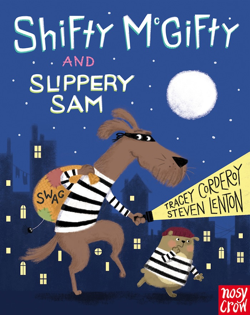 My first book, Shifty McGifty and Slippery Sam, with a rhyming text by Tracey Corderoy, was sent to me by publisher Nosy Crow and has sold phenomenally well in the UK, been translated into two other languages, spawning two sequels and numerous sell-out events including the Hay and Edinburgh Festivals.
My first book, Shifty McGifty and Slippery Sam, with a rhyming text by Tracey Corderoy, was sent to me by publisher Nosy Crow and has sold phenomenally well in the UK, been translated into two other languages, spawning two sequels and numerous sell-out events including the Hay and Edinburgh Festivals.
My first author/illustrator title Princess Daisy and the Dragon and the Nincompoop Knights was originally written in prose but we felt that it would be a stronger, funnier book if it rhymed. So, a few re-writes later (keeping the aforementioned open mind!), and a fun, hopefully popular new fairytale has been born. If your book is stronger in rhyme, as long as it has good scansion (flows beautifully) you could be on to a winner!
5. Do dip your toe into Twitter
I never understood Twitter until I started researching and promoting my work. Find your ‘Twitter tone’ and engage your potential audience with anecdotes, fun facts, quotations, sketchbook work, anything that will intrigue people and get them interested in what you’re about and what you are striving to create. There are a number of publishers who keep an eye on Twitter for the next big illustrator so log in and have fun with it. Just don’t stalk Paul Hollywood, OK?
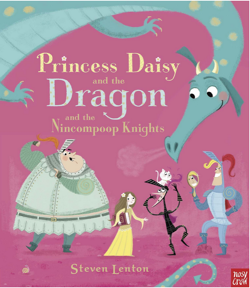 6. Don’t think you have to be an expert at everything
6. Don’t think you have to be an expert at everything
When I entered the industry I panicked because I’m not the best at typography and hand lettering, so how on earth was I going to design an entire book? This panic was unfounded because as soon as I signed the contract I was surrounded by a helpful team of editors, designers and publicists who all want to make sure that I was happy, supported and comfortable with all decisions and practicalities that went into the development, execution and marketing of my book. Everyone is on your side and everyone wants to create the best book that you can possible make. Don’t be afraid to ask for help and opinion along the way. Over cake.
7. Most importantly – DO keep a positive outlook
Despite numerous rejection letters and emails I stuck to my guns and kept a positive view on my ambition. When I sent my beautifully designed gift box full of pom-pom dogs, artwork and dummies to Walker Books I convinced myself that they would snap me up then and there. They didn’t, of course, and I was left feeling rather flat – all that effort gone to waste! But I dusted myself off and developed more ideas that eventually lead to my first contract.
There have been times when my confidence has taken a nose-dive and times when I have been frustrated at the often slow pace of the industry as a whole. But keep pushing yourself, keep your humour, and keep drawing. Publishers like to have meetings with friendly, jolly people with a wealth of sketchbooks and ideas, so get in touch with that agent, focus that folio and get out there – it really is worth it. Keep envisaging your book on a shelf in Waterstones. The feeling you get when you pick it up for the first time is an incomparable thrill and all the heartache and self-doubt will swiftly be forgotten… until you get working on book two!

March 4, 2015
10 tips to learn from a creative writing lecturer
This post first appeared on the On the Write Track blog.
Some people enjoy writing for the sake of it, while others want to develop and improve. If you fall into the latter category then read this. A creative writing lecturer and published author with a new novel The Dark Light out in July 2015, Julia Bell is one of the UK’s foremost authorities on creative writing. Here, she shares with us the top ten pieces of advice she gives her students at the start of each year.
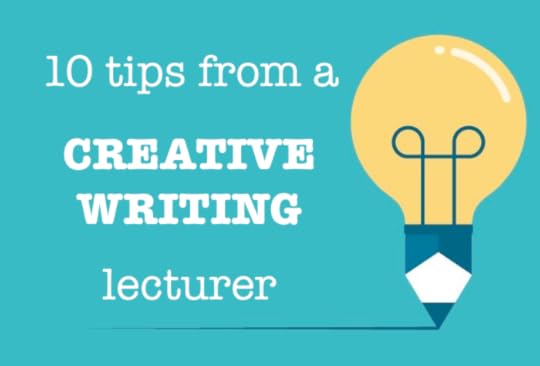
Sometimes as a teacher you feel like you’re trapped in a groundhog day, repeating the same pieces of advice every year, just to a different cohort of students, although as I get older and more forgetful perhaps I’m just repeating myself and students are being too polite to call me on it.
In any given year these are the pointers about writing good prose – novels and stories – that I find myself saying over and over, but they are also in themselves, light bulb moments from my own practice as writer.
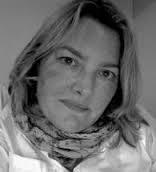 Julia Bell’s top ten writing advice tips:
Julia Bell’s top ten writing advice tips:1. A good piece of writing is an experience for the reader. The meaning of a story or a novel does not pre-exist the writing of it. You can’t write with a manifesto in your hand unless you are intent on writing parables or sermons. Technique – point of view, character, sentence structure, style – are all in service to the creation of this experience.
2. The writing of a story should be an experience for the writer too. The work needs to transmit something – love, anger, jealousy, rage, disturbance, (add your own abstract noun here) – but you can’t experience these abstractions in prose just by using the abstract noun. In fiction, meaning is delivered through concrete detail and description. Don’t tell me that your character is angry, show them throwing the ashtray. As a rule of thumb if your work makes you feel – cry, laugh, explode – chances are it’s transmitting something of this to the reader too.
3. Make your story question the world. A story should never set out to answer a question, rather it should pose the question correctly. Here I am paraphrasing advice from Chekhov. Good writing offers up a knotty picture of the world for a reader to untangle: Over here, reader! Look at this tangle of thorns! A story which ties everything up in neat conclusions might be more commercial (read Disney) but if it doesn’t make us question the world then it cannot claim to be art.
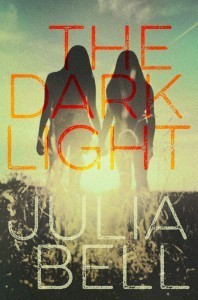 4. Cut out all unnecessary words. Frilly language just gets in the way. If you’re going to write stylishly read lots of poetry and think about rhythm. Good sentences are concrete and they choreograph the action for the reader – too many flouncy words just get in the way of what’s going on and makes the action and characterisation hard to see.
4. Cut out all unnecessary words. Frilly language just gets in the way. If you’re going to write stylishly read lots of poetry and think about rhythm. Good sentences are concrete and they choreograph the action for the reader – too many flouncy words just get in the way of what’s going on and makes the action and characterisation hard to see.
5. Get used to editing. You will write a lot of words that you don’t need as you get to know your characters. Those paragraphs of back story? They are mostly character notes that are helping you get to know your character but they are also holding up the flow of the story. Cut ruthlessly.
6. When editing, look for the sentences that should be paragraphs and the paragraphs that should be sentences. That means the places where you can move more swiftly and you’ve waffled on with something which you could deliver in a line, and where you’ve delivered something in a line which is worth expanding into a paragraph or scene. Good time management is key to this.
7. The beginning point for a writer and a reader are in two different places. The opening paragraph of a published book is often a polished affair written at the end of the project when the writer knows what it is they are offering the reader. As a writer, when you start a story everything is provisional until you have finished it so don’t over polish your beginning – you may end up having to cut it anyway.
8. It’s better to have a ‘frankendraft’ than 10,000 words of finely wrought prose. Writers are often paralysed by the idea of writing a bad sentence but until you’ve finished a project you have no idea of what you’ve got. A potential novel is just that, the real novel is the one you actually wrote. Better to push on to the end of something than agonise over sentences. The whole thing will need redrafting anyway – when you have finished a piece, however unwieldy and full of mistakes, you actually have the raw material to work with and turn into something better.
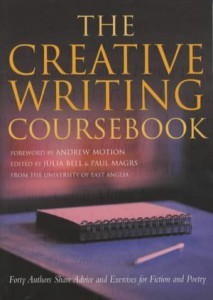 9. Don’t assume the ‘frankendraft’ is good enough. You finished your book – congratulations. Now the hard part starts. Agents dread the months post NaNoWriMo because they get heaps of unsolicited submissions from people who wrote a novel in a month and think that’s all there is to it. Please go back to point 1. Editing always makes the work better.
9. Don’t assume the ‘frankendraft’ is good enough. You finished your book – congratulations. Now the hard part starts. Agents dread the months post NaNoWriMo because they get heaps of unsolicited submissions from people who wrote a novel in a month and think that’s all there is to it. Please go back to point 1. Editing always makes the work better.
10. No one can do the work for you. There is no substitute for the work. If you want to write a book do it, don’t dream about doing it. And worst of all don’t bitch at others for achieving something you haven’t had the guts to get on with. Rivalry is useful if it’s inspiring you to write better, harder, faster. If you’re just jealous because they’ve done the work and you haven’t there is very little that can be done to help you.

February 9, 2015
Talking Point: Fifty Shades of Grey
This article first appeared in issue 2 of Publishing Talk Magazine (Sep-Oct 2012). The film adaptation releases this week.
Danuta Kean looks at the fastest-selling paperback of all time – the publishing phenomenon that is Fifty Shades of Grey – and asks: “Why?”
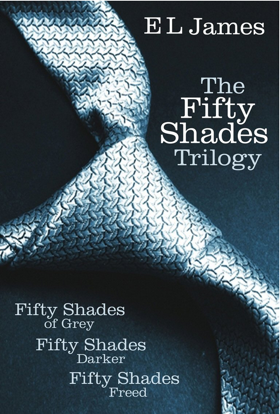 There were seven women in my carriage as our train sped through Northamptonshire to London. Two of them looked like students who had been home to Mum and Dad for the weekend to get their washing done; one was an elegant 60-something, another was a young woman with a sour-faced boyfriend at her side. They made a sundry group, but these women did have one thing in common: they were all sitting on that train reading the publishing phenomenon of the moment – E L James’s unintentionally hilarious erotic novel, Fifty Shades of Grey.
There were seven women in my carriage as our train sped through Northamptonshire to London. Two of them looked like students who had been home to Mum and Dad for the weekend to get their washing done; one was an elegant 60-something, another was a young woman with a sour-faced boyfriend at her side. They made a sundry group, but these women did have one thing in common: they were all sitting on that train reading the publishing phenomenon of the moment – E L James’s unintentionally hilarious erotic novel, Fifty Shades of Grey.
My mood, which had been good all weekend while I chaired events at the Althorp Literary Festival, soured as I looked at these women and suddenly felt as if I had stumbled on the annual outing of the Desperate Housewives’ Club. What on earth has happened to my gender, I wondered, that we are reading, en masse, a book so badly written it has spawned several websites set up purely to mock it?
Fifty Shades of Grey tells the story of a monstrous relationship between a virginal young woman and an exploitative and cruel man with a penchant for sado-masochism.
Women young and old, rich and poor, are reading this book and its two sequels in such huge numbers that sales have now surpassed 30 million in the US and UK – beating Harry Potter and The Da Vinci Code to make Fifty Shades the fastest-selling paperback on record. In literary terms, it is dreadful. The plot alone would make Harry reach for his potions.
So why is a novel of such execrable prose – I quote: “My inner goddess is doing the meringue with some salsa moves” – suddenly a bestseller? And what does its popularity say about the women who are buying it in droves? One reason may be its role as ‘Mummy Porn’ – safe but stirring erotic fiction, which titillates the middle-class mothers of suburbia.
When a friend asked two female colleagues why they bought the book, they said: “To see what the fuss was about”. Millions of women may be buying the book out of curiosity, but it seems some are becoming more adventurous in the bedroom as a result – leaving their appreciative husbands writing five-star reviews of Fifty Shades of Grey on Amazon.
The book enjoys the frisson of being forbidden fruit, but at the same time it is entirely safe because it is fashionable. It’s being talked about by respectable literary and academic pundits – and everybody else is reading it too. In a previous age, DH Lawrence’s Lady Chatterley’s Lover had the same impact.
But I believe the real reason for the book’s popularity is that, consciously or subconsciously, it exploits one of the oldest ideas in society: the Freudian notion that all women are either Madonnas or whores. However, Fifty Shades offers a get-out-of-jail-free card: it says you can still be a Madonna, while acting like a whore. Ana may have wild sex with Christian, but wash off the whipped cream and undo the shackles, and the nice girl is still there. Even better: a handsome billionaire loves her.
It’s not just sex that women escape into in Fifty Shades of Grey. More 1812 than 2012, it harks back to an age when women were not burdened with responsibility. It is no coincidence that the book’s success follows the surge in popularity of historical novels and dramas such as Downton Abbey and Call the Midwife. All reflect a traditional universe in which women know their places, where the gender roles were more clearly defined and delineated.
There is something liberating about a fantasy in which we sign over responsibility to someone else – though I doubt the appeal would be nearly as strong if Fifty Shades’ male protagonist, Christian, was poverty-stricken and ugly. Ana submits to Christian’s rule on everything, from what she eats to what she wears.
It is, of course, a fantasy with a track record. Other female protagonists in recent best-selling fiction inhabit a very conservative universe. Larsson’s Girl With The Dragon Tattoo, Dan Brown’s Sophie Neveu in The Da Vinci Code, Helen Fielding’s Bridget Jones and James’s Ana are all redeemed by men. Fifty Shades of Grey is the latest in a long line of books that imply that women haven’t progressed much beyond the 1950s in how they view relationships. I believe this book was rescued from the dusty shelves of specialist bookshops where the dirty mac brigade hang out because it taps into the complex stresses created by equality.
By handing over all control and thinking to a man, Ana gets to have it all – including her damaged billionaire. That is the real fantasy in this book.
I asked my friend Jane why she had bothered to read Fifty Shades when the world is rich with wonderfully well-written books telling fresh and exciting stories. “Some of us work really hard all day in mind-numbing jobs and, at the end of the day, we don’t have the energy to do much more than vegetate in front of the telly,” she told me. Jane’s eyes narrowed. “I really enjoyed it. So shoot me.”
UPDATE: the Fifty Shades trilogy has now been translated into 51 languages worldwide and sold more than 100 million copies in ebook and print—making it one of the biggest and fastest-selling book series ever. The film adaptation of Fifty Shades of Grey releases this week, starring Jamie Dornan and Dakota Johnson as Christian Grey and Anastasia Steele. Here’s the trailer:
Have you read – or watched – Fifty Shades of Grey? What did you think? Let us know in the comments.

February 6, 2015
Thinking of joining a writing group? Ask yourself these 8 questions first
This post first appeared on the On the Write Track blog.
As a writer, active member and chair of the London Writers’ Cafe – one of the largest writing groups in the UK – Lisa Goll knows a thing or two about how to get the most from participating in a writing community. Here she shares her top tips on finding the group that’s right for you, what to expect on joining and how to survive the writing velociraptors.
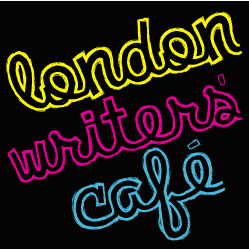 For most, creative writing is a solitary art – and it’s no mystery as to why; to create engaging characters, draw vivid scenes and devise believable incidents that will keep readers with you, is best done in the kind of seclusion only a die-hard hermit would envy. But no piece of work (no matter how talented its creator) goes from the page to minds without a bit of the heavy-lifting being done by an outsider. Whether it’s a professional editor, a trusted friend, or your mum – all writers need support, insight and small rounds of applause every now and then because there are just some things that can’t be assessed by the writer alone.
For most, creative writing is a solitary art – and it’s no mystery as to why; to create engaging characters, draw vivid scenes and devise believable incidents that will keep readers with you, is best done in the kind of seclusion only a die-hard hermit would envy. But no piece of work (no matter how talented its creator) goes from the page to minds without a bit of the heavy-lifting being done by an outsider. Whether it’s a professional editor, a trusted friend, or your mum – all writers need support, insight and small rounds of applause every now and then because there are just some things that can’t be assessed by the writer alone.
For instance: no matter what you’re writing you’re using words on a page to transfer imagery, action, emotion and meaning into readers’ minds – but how do you know if you’ve succeeded? This is the stuff of pervading anxiety that plagues every scribe. Without knowing how your text is landing in readers’ minds you’re working blind, and that’s never going to yield the best work.
Luckily, this is where writing groups live. But before you rush off to sign up to just any old one, you need to get sleuthing and find out:
1. Is it well-organised?
This can be tricky to judge before you’ve joined but most groups should say something about their last meeting and give information about the next (through emails, website, Twitter etc.) so you’ll quickly see if the group no longer exists or has ‘gone dark’. It can be very hard if meetings aren’t happening fairly regularly, especially if you’ll be expected to change your plans to suit the vagaries of last-minute scheduling.
2. Does is run to a format?
That is, do they share work, chat over drinks or only gather to write together? Again, think about what you want from a group and exclude any that don’t do what you need right now. Bookmark the others though – there’s nothing worse than trawling pages months later for that group that meet on every second Tuesday at 6:15pm for writing sprints at your local and being unable to find it!
3. Is it convenient?
 If meetings take place miles away, you’ll soon drop out. They say it takes three weeks to make or break any habit, so if you want to attend something fairly regularly search for meetings that are comfortable journey from home or work. And check where they hold their meetings; is it local pubs, libraries, cafés or at members’ homes? Home groups are normally fine (take a buddy to first meet, if you can) but joining may also mean you sign on to host in your front room.
If meetings take place miles away, you’ll soon drop out. They say it takes three weeks to make or break any habit, so if you want to attend something fairly regularly search for meetings that are comfortable journey from home or work. And check where they hold their meetings; is it local pubs, libraries, cafés or at members’ homes? Home groups are normally fine (take a buddy to first meet, if you can) but joining may also mean you sign on to host in your front room.
4. Do you want feedback?
If you decide you want to join a critiquing group, make sure you’ve sussed it out first. It’s sneaky, but try to contact other members beforehand for the real story – if you can. Organizers are sometimes so excited by a new member that they forget to mention that should you read work before the group, it will be torn to shreds faster than a keeper in a cage of velociraptors. On the other hand, beware groups where everything is ‘nice’. Being told something is nice, or ‘I liked it’, doesn’t help you, the writer, improve anything. After all, no one puts their car in for an MOT so the mechanics can wax lyrical about how much they like the chassis.
Organizers are sometimes so excited by a new member that they forget to mention that should you read work before the group, it will be torn to shreds faster than a keeper in a cage of velociraptors.
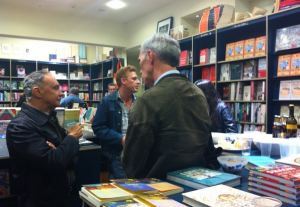 The best kind of writing feedback is balanced, constructive and, most importantly, specific. I like ‘I really enjoyed the way you have done x, y, z but I found a, b, c distracted me from your story. Have you considered doing e, f, g?’ Offering solid suggestions on how the work could be improved (without trying to rewrite their story in your way) is the most useful thing of all. Lastly, watch out for groups with a policy of ‘everyone contributes’. I’ve heard many harrowing stories of first-time writers being forced to read their work in barbaric hazing rituals that should have been outlawed decades ago.
The best kind of writing feedback is balanced, constructive and, most importantly, specific. I like ‘I really enjoyed the way you have done x, y, z but I found a, b, c distracted me from your story. Have you considered doing e, f, g?’ Offering solid suggestions on how the work could be improved (without trying to rewrite their story in your way) is the most useful thing of all. Lastly, watch out for groups with a policy of ‘everyone contributes’. I’ve heard many harrowing stories of first-time writers being forced to read their work in barbaric hazing rituals that should have been outlawed decades ago.
5. Are you ready to receive feedback?
As any author will tell you (in extremely gory detail), the rigour of critique starts from the moment you first show your work to another to the day your career concludes, but it’s not the easiest part of the job. Asking others to judge your work takes courage, resilience and patience, but if you’re not open to suggestions then asking for it wastes your time as well as theirs. During feedback: don’t talk, actively listen. It’s as easy and as inhumane as that. Nigh impossible when others are discussing your work to remain mute (I know) but nothing else gets you the kind of feedback you can really use.
6. Is it a safe environment?
Sharing your work in exchange for feedback takes guts – but it also should be moderated by a third-party. I don’t hold much respect for online forums where any writer can share or comment on work anonymously as exchanges often descend into the kind of meanness and haranguing that kill dreams. So make sure that, if your work is going to be exchanged, expectations of respectful critique are plain to all. Nothing worse than sending work off and having to swallow a chill pill before you can open your inbox again.
Make sure if your work is going to be exchanged, that expectations of respectful critique are plain to all. Nothing worse than sending work off and having to swallow a chill pill before you can open your inbox again.
7. Is it social?
Alone time is key to any writer’s success – but what about life? If you never go out and meet people how on earth will you invent your next set of believable heroes and villains? Groups that offer organized socialising, not just writing chatter, are so great. Writing is demanding enough so avoid any group with signs of fun-police tendencies – normally indicated if they have a lot of RULES – because having a place where you can rant about your characters running amok, but also about how you would like to climb the Three Peaks next year is a boon.
8. Is it on your level?
If you’re just starting out and the group you’ve found is made up of published novelists it may not be the right one for you. Or, if you’ve completed three novels and have stories being regularly published in magazines, you might find a group made entirely of beginners a bit hard going. If it doesn’t say anything about what stage their members have reached then ask for more information. Beyond that, you’ve just got to try them out. It might be that going to a group of complete beginners releases you from the tortures of perfectionism, or a group made up of published authors may act as powerful motivator if you’re just getting started.
Finally, my advice is always to try out every group until you find what you need. Don’t pay top dollar for any of them though (unless you really want to) and always, always, remember a writing group only works if you’re writing so… get to it!







